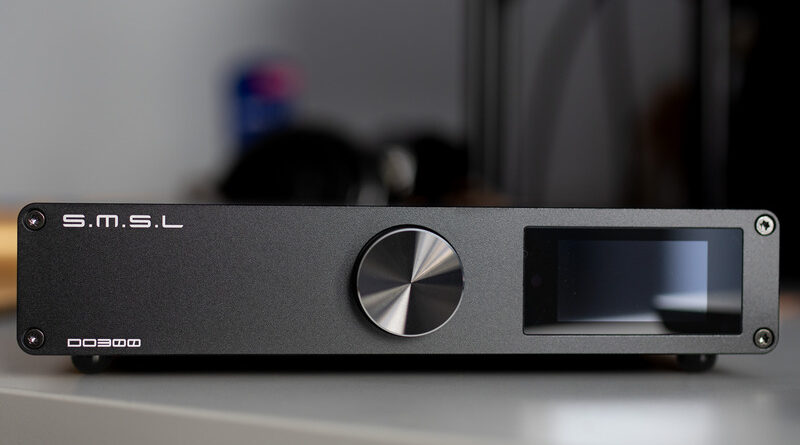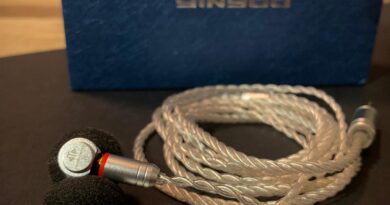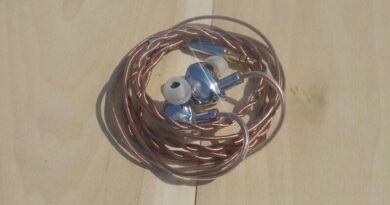SMSL DO300 DAC Review – Spec Monster
Pros — Solid build
– Low-noise PSU
– Many input and output options including I2S
– Remote control works well
– Highly resolving signature
– Excellent macrodynamic punch and bass slam
– Reconstruction filters and tone colors allows further sonic customization
– MQA certification and full MQA decoding
Cons — DO300 chassis is a fingerprint magnet
– Stage depth and microdynamics are lacking in comparison to higher end DACs
– Rotary encoder feels cheap
– Subpar playback of DSD files
– Too many similar options in SMSL’s own lineup
In this Article
INTRODUCTION
SMSL has become immensely popular in recent years, thanks to the consistent delivery of well-measuring and well-specced source devices that match or undercut the competition in terms of many objective metrics.
The DO300 DAC is the latest in line of products that have a very impressive spec-sheet while the asking price is relatively modest. DO300 is also one of the first DACs to utilize the latest and greatest ESS Sabre ES9039MSPro chip, sporting class leading distortion figures and dynamic range. There is also numerous input and output options to mix and match with any system out there.
So, does the DO300 manage to harness the TOTL DAC chip inside to its full potential, or do they end up being another generic release? Let’s find out.
Note: the ratings given will be subjective to the price tier. Aoshida Audio was kind enough to provide me the DO300 for review.
Headphones and IEMs used: Sennheiser HD650, Hifiman HE-6se V2, Sennheiser IE 900
Price, while reviewed: $550. Can be bought from Aoshida Audio.
PHYSICAL THINGS AND USABILITY
PACKAGING AND ACCESSORIES
The packaging is a fairly basic cardboard box. Inside, you get the DO300 DAC itself, a power cable, an USB type-B to type-A cable, and a remote control. No batteries are included.
BUILD QUALITY
Build quality is good in general. The DO300 will not impress with its density or heft, but the CNC-milled aluminum chassis has smooth finish all around with a matte black paint-job. I am not a fan of the coating though, it catches fingerprint and grease all too readily.
The front panel is basically a large rotary encoder with a color LCD beside it to show the line-out gain, current phase, sampling rate, and input type. The LCD is not the best in terms of fidelity, with the contrast being lower than your typical smartphone. Then again, this is a mid-priced DAC and even higher tier ones employ far cheaper displays at times.
i do wish the LCD display showed a few more information, like the current selected filter, tone color enhancements etc. On a similar note, the rotary encoder is not my favorite. It has distinct steps but the feedback is somewhat mushy. There’s also some wobble to it when pressing down (to select an option, for example), which further cheapens the feeling.
As a result, I mostly operated the unit with the supplied remote control which makes it much easier to change the various tone colors, filters etc.
Now let’s move on the other ports on the back. You have the COAX/TOSLINK inputs, the usual USB input (type-B port), I2S, AES/EBU, and Bluetooth inputs. Outputs include both RCA (single-ended) and 3-pin XLRs (balanced).
SMSL basically put in every common input and output types in the market, so most users should not face an issue integrating this DAC into their chain, whether they’re running a small desk setup or a full-fledged stereo rig. I do wish the USB port was type-C because, well, type-C everything is the mantra nowadays (albeit type-B is more robust).
Some notes about the I2S input: I could not test it out due to the lack of such a device at my disposal. However, I shall receive the Cayin N7 soon, which has I2S out. I will update the sound section with impressions regarding I2S input if the difference is noticeable.
So, in essence: good build quality, with no visible imperfections or issues. The rotary encoder could be better though, and type-C input would be nice.
SPECIFICATIONS
The official specs are as follows:

The interesting part here is the ESS Sabre ES9039MSPro chipset. Apart from that mouthful of a name, this is a completely redesigned chipset, as per ESS’ claims. However, they have historically been opaque with their datasheets (with manufacturers or DIY-ers often having to sign NDAs before getting intricate details about the implementation).
Some forum discussions hint at the 9039MSPro being just a more power-efficient 9038, but it’s all speculations and hearsay for the time being.
As for the BT chipset, Qualcomm QCC5125 is utilized. It supports all mainstream codecs including several AptX variants and LDAC. The BT version is 5.0 which is “older” than the latest 5.2, but this should not be too big an issue. The rest of the components includes XMOS XU-316 USB chipset, SMSL’s self-developed system clock, a low-noise linear PSU (which works surprisingly well at suppressing ground hum and RF interference), and 11 dual op-amps.
Another plus is the automatic switching between any voltage range between 100V – 240V. This helps in avoiding the mess of mistakenly connecting the plug without switching the voltage selector and damaging components. So, while the internals are not the most beefed up and do not use many discrete components, the design is competent and should be fine for most use cases.
SMSL DO300 TONALITY AND TECHNICALITIES
I find describing the tonality of digital sources a futile exercise, as most of the characteristics depend on the pairing with various headphones and IEMs. Nonetheless, there are some commonalities between all pairings.
However, I consistently noticed some sonic characters on the DO300, even in blind testing. Basically: the DO300 has a noticeably harder hitting bass slam, and the stage is slightly cramped compared to my reference setup. Microdynamics is another area where the DO300 struggled, with subtle shifts in volume not being as apparent as they are on the LPGT.
Another gripe of mine is the playback of DSD files. Basically – if you listen to many DSD files, skip the DO300 altogether. The replay gain is too high, reducing dynamic range and robbing the DSD files of their nuances during playback. I have a few albums in DSD so overall it was not an issue but the few DSD64 and DSD128 tracks I tried with the DO300, things were not pretty.
Before proceeding further, a description of the test setup is in order. I used the Lotoo PAW Gold Touch (LPGT) + Cayin C9 as the reference system, and the SMSL DO300 is replaced as the DAC for the A/B test (LPGT would then act as the transport). The amp was left untouched, ensuring volume matched comparison.
One interesting feature the DO300 has is “phase inversion” where phase issues on the output side can be compensated for. I’d recommend keeping it turned off unless things sound “strange” (e.g. the center instruments or vocals sound strangely compressed).
PAIRING NOTES
IEMs
The Sennheiser IE 900 show noticeably harder-hitting bass when the DO300 is used as the DAC in the chain. The stage is also narrowed, and stage depth is reduced compared to the LPGT. This “effect” was consistent between tracks. The treble fortunately did not sound “etched” or “fatiguing”, so SMSL has improved upon one of my complaints in their previous offering – the M400.
SoftEars Turii also showed similar change in bass response. It also highlighted the lack of stage depth compared to the LPGT’s DAC section. Imaging seemed fine, though center-imaging is more convincing on the LPGT.
Headphones
The story continues with headphones. Sennheiser HD650 do not benefit from added bass slam as the driver is just incapable of reproducing such low notes, but the mid-bass tightened up slightly. I also tried out the “tube” tone color with the HD650, and while it emulated the soft bass bloom of tube amps, the mids were not as “colored” as they are on the Xduoo MT-601S with tube buffer, for example. An actual OTL amp like the Bottlehead Crack will display even more dramatic difference between SMSL’s emulated tube effect and the real thing.
Speakers
Finally, I used the SMSL DO300 with my desk rig and desk speakers (KEF LSX), with the Questyle CMA Twelve Master being a point of comparison. The KEFs have a low-frequency cut around 70Hz, so the change in bass was mostly imperceptible. The staging was noticeably different between the Questyle and the SMSL, however.
Basically, the Twelve Master had wider, deeper staging as the vocals sat a few inches further away in the presentation. It is not midrange recession, mind you, rather the center imaging and stage depth that is more up-front and “in-your-face” on the SMSL DAC.
COMPARISONS
vs SMSL M400
The M400 is one of the older SMSL DACs that I have tried. It’s one of the few DACs to run the now defunct AKM AK4499 chip (AKM’s past flagship) and offers similar settings to the newer DO300 including tone color and reconstruction filters.
The signature has noticeable differences, however. The DO300 is not as etched in the treble as the M400, and the M400 also tended to push upper-mids a bit too forward. The DO300 is a step up on that front. Staging and imaging are similar on both, but the bass slams harder on the DO300 (which seems to be a thing of this DAC at this point).
So, should existing M400 users upgrade? I think the DO300 is better, but the differences are subtle and a change of amp will have more profound effect. The bass and macrodynamic punch is definitely noticeable, so if you are into that, the DO300 can be an upgrade on that front.
CONCLUDING REMARKS
The DO300 is competent, no doubts about that. It measures well, has every input and output you may possibly want, and the BT support is the proverbial cherry on top (though I find BT audio lacking vs the usual wired affair and as such – ignore it unless absolutely necessary). The build is good and stock accessories are good enough to get you going.
Speaking of the sound, DO300’s bass reproduction is truly satisfying. If you like “slammy” bass – this won’t disappoint at all. Staging and imaging could be better, however, so could be the rendition of microdynamics. DSD files are played back with too high a gain, reducing DR in the process, so DSD collectors should skip this one
The big issue lies elsewhere – it’s about SMSL saturating its own lineup. There is the DO200 mk2, the D400ES, the D300 (with ROHM DAC), and even more upscale options in their VMV lineup of products. It gets dizzying, confusing, and the average consumer might even give up since there is no clear delineation between these products.
Nonetheless, if you are looking for a midrange DAC with most common inputs, some “sound shaping” via reconstruction filters and tone coloration/DSP options, and don’t care about DSD – then the DO300 is a good option. It’s overall better than the M400 it’s essentially replaced, though given SMSL’s rapid-fire release schedule, this one might get replaced soon anyway.
Despite that possibility, the DO300 gets a recommendation based on how solid an offering it is, all things considered.
DISCLAIMER
Get it from Aoshida Audio
Our generic standard disclaimer.
You find an INDEX of our most relevant technical articles HERE.







